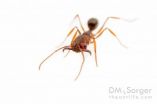(Press-News.org) Children who spend more time in less structured activities—from playing outside to reading books to visiting the zoo—are better able to set their own goals and take actions to meet those goals without prodding from adults, according to a new study by the University of Colorado Boulder.
The study, published online in the journal Frontiers in Psychology, also found that children who participate in more structured activities—including soccer practice, piano lessons and homework—had poorer "self-directed executive function," a measure of the ability to set and reach goals independently.
"Executive function is extremely important for children," said CU-Boulder psychology and neuroscience Professor Yuko Munakata, senior author of the new study. "It helps them in all kinds of ways throughout their daily lives, from flexibly switching between different activities rather than getting stuck on one thing, to stopping themselves from yelling when angry, to delaying gratification. Executive function during childhood also predicts important outcomes, like academic performance, health, wealth and criminality, years and even decades later."
The study is one of the first to try to scientifically grapple with the question of how an increase in scheduled, formal activities may affect the way children's brains develop.
Munakata said a debate about parenting philosophy—with extremely rigid "tiger moms" on one side and more elastic "free-range" parents on the other—has played out in the media and on parenting blogs in recent years. But there is little scientific evidence to support claims on either side of the discussion.
Jane Barker, a CU-Boulder doctoral student working with Munakata and lead author of the study, said, "These are societally important questions that come up quite often in social commentary and casual conversations among parents. So it's important to conduct research in this area, even if the questions are messy and not easy to investigate."
For the study, parents of 70 6-year-olds recorded their children's daily activities for a week. The scientists then categorized those activities as either more structured or less structured, relying on existing time-use classifications already used in scientific literature by economists.
"These were the best and the most rigorous classifications we could find," Barker said. "They still fail to capture the degree of structure within specific activities, but we thought that was the best starting point because we wanted to connect this with prior work."
In that classification system, structured activities include chores, physical lessons, non-physical lessons and religious activities. Less-structured activities include free play alone and with others, social outings, sightseeing, reading and media time. Activities that did not count in either category include sleeping, eating meals, going to school and commuting.
The children also were evaluated for self-directed executive function with a commonly used verbal fluency test.
The results showed that the more time children spent in less structured activities, the better their self-directed executive function. Conversely, the more time children spent in more structured activities the poorer their self-directed executive function.
Because some of the existing time-use categories might not reflect the real amount of structure involved in an activity, the researchers also did several rounds of recalculation after removing categories that were questionable. In each case the findings still held. For example, the time-use categories classify media screen time as unstructured, but the degree of structure depends on whether a child is watching a movie or playing a video game. However, when media time was removed from the data, the results were the same.
"This isn't perfect, but it's a first step," said Munakata. "Our results are really suggestive and intriguing. Now we'll see if it holds up as we push forward and try to get more information."
The researchers emphasize that their results show a correlation between time use and self-directed executive function, but they don't prove that the change in self-directed executive function was caused by the amount of structured or unstructured time. The team is already considering a longitudinal study, which would follow participants over time, to begin to answer the question of cause.
INFORMATION:
Other study co-authors are undergraduate alumnus Andrei Semenov, doctoral student Laura Michaelson and professional research assistant Lindsay Provan, all from CU-Boulder, and Hannah Snyder, a former CU-Boulder doctoral student and current postdoctoral researcher at the University of Denver. The study was funded by the National Institute of Child Health and Human Development.
Read the study at http://journal.frontiersin.org/Journal/10.3389/fpsyg.2014.00593/abstract.
Kids whose time is less structured are better able to meet their own goals
2014-06-18
ELSE PRESS RELEASES FROM THIS DATE:
Dismisses link between suicidal behaviour and ADHD drugs
2014-06-18
A new register-based study from Karolinska Institutet in Sweden shows that drug therapy for ADHD does not entail an increased risk of suicide attempts or suicide, as was previously feared. The results are published in the British Medical Journal (BMJ).
"Our work in several ways shows that most likely there is no link between treatment with ADHD drugs and an increased risk of suicide attempts or suicide. The results rather indicate that ADHD drugs may have a protective effect," says Henrik Larsson, researcher at the Department of Medical Epidemiology and Biostatistics, ...
New horned dinosaur reveals unique wing-shaped headgear
2014-06-18
Cleveland, Ohio - Scientists have named a new species of horned dinosaur (ceratopsian) based on fossils collected from Montana in the United States and Alberta, Canada. Mercuriceratops (mer-cure-E-sare-ah-tops) gemini was approximately 6 meters (20 feet) long and weighed more than 2 tons. It lived about 77 million years ago during the Late Cretaceous Period. Research describing the new species is published online in the journal Naturwissenschaften.
Mercuriceratops (Mercuri + ceratops) means "Mercury horned-face," referring to the wing-like ornamentation on its head ...
Spanish slug -- Busting an invasion myth
2014-06-18
Frankfurt am Main, Germany, June 18th 2014. Spanish slugs (Arion lusitanicus) are one of the most common slug species in Central Europe. The animals sometimes nicknamed "killer slugs" are known to do their fair share of damage in fields and gardens. The slug was thought to have originated in Southern Europe. However researchers of the German Biodiversity and Climate Centre and the Goethe University now found out, that the prime example of an invasive species is originally from Central Europe and thus no "immigrant" after all. Control measures, such as the EU regulation ...
New study is first to identify, clarify MERS-related abnormality distribution on CT
2014-06-18
Leesburg, VA, June 18, 2014—Researchers in Saudi Arabia have identified key defining characteristics of Middle East Respiratory Syndrome (MERS) in CT imaging of patients confirmed as having the disease.
The study found that the most common CT finding in hospitalized patients with MERS infection is suggestive of an organizing pneumonia pattern.
"A few studies have described variable degrees of lung opacities in patients with MERS, but did not clearly address their exact distribution," said Amr M. Ajlan, the corresponding author of the study. "Because we evaluated the ...
Study shows cost-effectiveness of smoking cessation counseling during hospitalization
2014-06-18
OTTAWA, June 18, 2014 – In a recent study published in Tobacco Control, researchers at the University of Ottawa Heart Institute have demonstrated the cost-effectiveness of the Ottawa Model for Smoking Cessation (OMSC), an intervention that includes in-hospital counseling, pharmacotherapy and post-hospital follow-up, compared to usual care among smokers hospitalized with acute myocardial infarction, unstable angina, heart failure, and chronic obstructive pulmonary disease.
The study examined patients hospitalized in Ontario, a province with a population of approximately ...
Animals conceal sickness symptoms in certain social situations
2014-06-18
The review's sole author, Dr. Patricia Lopes from the Institute of Evolutionary Biology and Environmental Studies at the University of Zurich, says that animals from a number of different species will eat and drink less, reduce their activity and sleep more when they are sick in order to conserve energy for their recovery. However, this can all change depending on the social situation.
In a paper published this week in the journal Proceedings of the Royal Society B, Lopes reviewed a range of different social situations that affected the behavior of sick animals, including ...
Childhood maltreatment associated with cerebral grey matter abnormalities
2014-06-18
An international study has analysed the association between childhood maltreatment and the volume of cerebral grey matter, responsible for processing information. The results revealed a significant deficit in various late developing regions of the brain after abuse.
According to the World Health Organisation (WHO), child maltreatment is defined as all forms of physical and/or emotional ill-treatment, sexual abuse, neglect or negligent treatment or commercial or other exploitation, resulting in actual or potential harm to the child's health, survival, development or dignity ...
Trap-jaw ants spreading in southeastern United States
2014-06-18
Trap-jaw ant species are active hunters with venomous stings and jaws powerful enough to fling themselves through the air. According to new research, they are also spreading into new territory in the southeastern United States. The research was done by scientists at North Carolina State University, the Mississippi Entomological Museum, the University of California, Davis and Archbold Biological Station.
"The fact that some of these species are spreading is interesting, in part, because these giant ants have managed to expand their territory without anyone noticing," says ...
Scientists about sequencing data: We drown in data but thirst for knowledge
2014-06-18
While more and more genomic information is becoming available at a drastically increasing pace, the knowledge we can gain about how microorganisms interact with their surrounding, infect hosts and alter their molecular programs in accordance to changing environmental conditions remains widely not deducible from genomic data alone, the researchers from University of Southern Denmark claim. This raises questions regarding the value of newly sequenced species.
The researchers have analyzed the genomes that are available from the past 20 years of sequencing bacterial DNA. ...
Horizontal levitation: The ultimate solution to particle separation
2014-06-18
Magnetic separators exploit the difference in magnetic properties between minerals, for example when separating magnetite from quartz. But this exercise becomes considerably more complex when the particles are not magnetic. In the wake of previous particle levitation experiments under high-power magnetic fields, a new study reveals that particles are deflected away from the magnet's round-shaped bore centre in a horizontal direction. Previous studies had observed the vertical levitation of the particles. These findings are presented by Shixiao Liu from the Faculty of Engineering, ...




